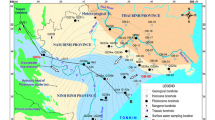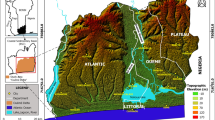Abstract
This paper reports a hydrogeological characterization of a groundwater-dependent lakes system, the Lakes Kosi Bay catchment located in the north-eastern coast of South Africa. Conventional hydrogeological techniques including water balance analysis, hydrogeochemical and environmental isotope methodologies were applied in the study. Three distinct aquifer systems are recognized in the area, namely the unconfined Holocene cover sands, the Kosi Bay and Port Durnford Formations, and the Umkhwelane and Uloa Formations. Groundwater recharge to the topmost aquifer, which is connected to the lakes, is estimated using the chloride mass balance method to be 12 % of the mean annual precipitation (MAP = 939 mm/a). Evaporation rate from the lakes and evapotranspiration from the catchment are 1310 and 1135 mm/a, respectively. The mean annual water balance components indicate a positive balance between inputs and outputs. Groundwater flows from the west through the lakes (flow-through lakes) to the Indian Ocean. Groundwater in the shallow Holocene aquifer and streams has similar hydrochemical and isotopic signature indicating strong interconnection. These groundwater and streams have a hydrochemistry dominated mainly by a Na–Cl–HCO3 water type, a very low salinity (ranging from 88 to 400 µS/cm) and a negative isotopic signature (negative δD and δ18O values). The lakes are characterized by Na–Cl hydrochemical water type, have salinity that ranges from 1014 to 25,300 µS/cm, and positive stable isotopic signature (positive δD and δ18O signature) indicating strong evaporation effects. The study further reveals a salinity and isotopic series among the lakes from south to north, towards the estuary.
Similar content being viewed by others
References
Allen RG, Pereira LS, Raes D, Smith M (1998) Crop evapotranspiration: guidelines for computing crop water requirements. Irrigation and drainage paper No. 56. Food and Agriculture Organization of the United Nations, Rome
Bredenkamp DB, Botha LJ, Van Tonder GJ, Van Rensberg HJ (1995) Manual on quantitative estimation of groundwater recharge and aquifer storativity. WRC Project No TT 73/95. ISBN 1 86845 1763. Pretoria
Cooper JAG, Kilburn RN, Kyle R (1989) A late Pleaistocene molluscan assemblage from Lake Nhlange. Zululand and its paleaoenvironmental implications. S Afr J Geol 92:73–83
Craig H (1961) Isotopic variations in meteoric waters. Science 133:1702–1703
Dupuit J (1863) Étudesthéoriquesetpractiquessur le mouvement des eauxdans les canauxdécouvertset á travers les terrains perméables, 2nd edn. Dunod, Paris
DWS (2015) Lake level data for the Lakes Nhlange, Makhwulani and Mpungwini. Digital information supplied by the Department of Water Affairs and Sanitation, May 2015
Eriksson E, Khunakasem V (1969) Chloride concentration in groundwater, recharge rate and rate of deposition of chloride in the Israel coastal plain. J Hydrol 7:178–197
GRIP (2013) Groundwater resource information project. Digital information as supplied by the Department of Water Affairs, April 2013
Hunter IT (1988) Climate and weather off Natal in Coastal Ocean Studies of Natal, South Africa. In: Schumann EH (ed) Lecture notes on coastal and estuarine studies, vol 26, pp 81–100 (unpublished lecture note)
Jeffares & Green (Pty) Ltd (2012) UMkhanyakude district municipality groundwater monitoring network. Implementation report. Jeffares & Green (Pty) Ltd. Project Number 2911
Kelbe BE, Germishyse T (2000) The interaction between Coastal Lakes and the surrounding Aquifer. International Association of Hydrogeologists. Congress 2000, Cape Town, 26 Nov–1 Dec 2000
Kelbe BE, Germishuyse T, Snyman N, Fourie I (2001) Geohydrological studies of the primary coastal aquifer in Zululand. WRC Report No. 720/1/01. Pretoria. WRC
Meyer R, Godfrey L (1995) KwaZulu-Natal Geohydrological Mapping Project: Mapping Unit 7. CSIR Report No. EMAP-C-95024. Pretoria.CSIR
Meyer R, De Beer JH, Blume J (1982) A geophysical-geohydrological study of an area around Lake Sibayi, northern Zululand. Confidential CSIR Report Kon/Gf/81/1
Meyer R, Talma AS, Duvenhage AWA, Eglington BM, Taljaard J, Botha JP, Verwey J, van der Voort I (2001) Geohydrological investigation and evaluation of the Zululand coastal aquifer. WRC Report No. 221/1/1. Pretoria. WRC
National Water Act of South African (1998) Government Gazette, 19182. Act 36, 26 August 1998. Pretoria, South Africa
Porat N, Botha GA (2008) The chronology of dune development on the Maputaland coastal plain, southeast Africa. Quat Sci Rev 27:1024–1046
Ramsay PJ (1995) 9000 years of sea-level change along the southern African coastline. Quat Int 31:71–75
Ramsay PJ, Cooper JAG (2002) Late quaternary sea-level change in South Africa. Quat Res 57:82–90
SAWS (2015) South African Weather Service. Digital Meorological Data supplied by the Durban Weather Office, December 2015
Shaw EM (1994) Hydrology in practice, 3rd edn. Chapman & Hall, London, p 569
United Nations Educational, Scientific and Cultural Organization (2015) ISimangaliso Wetland Park. http://whc.unesco.org/en/list/914. Accessed 10 July 2015
United States Department of Agriculture (1986) Urban hydrology for small watersheds. Technical Report No. 55
Van Wyk E (2013) Local meteoric water line for northern KwaZulu-Natal Province of South Africa, Department of Water Affairs and Forestry (Personal communications)
Walther SC, Neumann FH (2011) Sedimentology, isotopes and palynology of late Holocene cores from Lake Sibaya and the Kosi Bay system (KwaZulu-Natal, South Africa). S Afr Geogr J 93(2):133–153
Weitz J, Demlie M (2014) Conceptual modelling of groundwater-surface water interactions in the Lake Sibayi Catchment, Eastern South Africa. J Afr Earth Sci 99:613–624
Weitz J, Demlie M (2015) Hydrogeological system analysis of the Lake Sibayi catchment, North-eastern South Africa. S Afr J Geol 118(1):91–106
Worthington PF (1978) Groundwater conditions in the Zululand coastal plain around Richards Bay: an intergrated case history of detailed hydrogeological evaluation. Report No. RFIS 182. Council for scientific and industial research. Pretoria
Wright CI (2002) Aspects of the Cenozoic evolution of the northern KwaZulu-Natal coastal plain, South Africa. Bulletin No. 132, Council for Geoscience
Wright CI, Cooper JAG, Kilburn RN (1999) Mid Holocene palaeoenvironments from Lake Nhlange, northern KwaZulu-Natal, South Africa. J Coast Res 15(4):991–1001
Wright CI, Miller WR, Cooper JAG (2000) The late Cenozoic evolution of coastal water bodies in Northern KwaZulu-Natal, South Africa. Int J Mar Geol Geochem Geophys 167:207–222
Acknowledgments
The authors would like to acknowledge the South African Water Research Commission and the University of KwaZulu-Natal for financially supporting the research. The authors are grateful to the Department of Water Affairs and Sanitation and the South African Weather Services for providing groundwater level and weather data of the study area, respectively. The iThemba Environmental Isotope Laboratories in Gauteng are acknowledged for the analysis of isotope samples. Jannie Weitz’s unreserved assistance during field data collection is highly appreciated. We thank the editors and the anonymous reviewer for their valuable comments on the manuscript.
Author information
Authors and Affiliations
Corresponding author
Rights and permissions
About this article
Cite this article
Ndlovu, M., Demlie, M. Hydrogeological characterization of the Kosi Bay Lakes system, north-eastern South Africa. Environ Earth Sci 75, 1334 (2016). https://doi.org/10.1007/s12665-016-6164-6
Received:
Accepted:
Published:
DOI: https://doi.org/10.1007/s12665-016-6164-6














